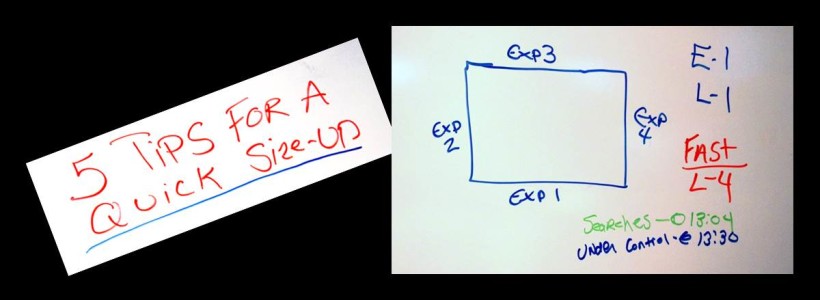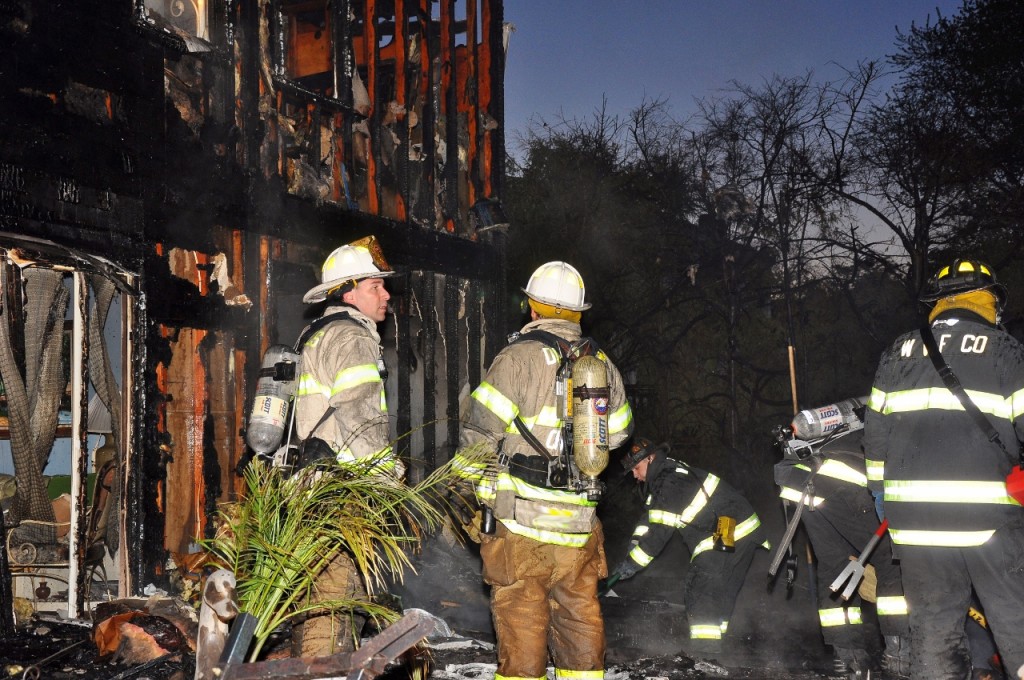5 Tips For A Quick Size-Up
The first arriving officer (whether a chief, engine company or ladder company officer) at the scene of a working fire is tasked with many responsibilities. They must convey a variety of information over the radio, essentially make sense out of an often chaotic scene and direct their crew and/or incoming crews the strategy that will be implemented to attack and extinguish the fire.
The Academy Size-Up Protocol
We are taught in our basic fire school the correct 13 point size-up can be remembered as the acronym COAL WAS WEALTH. Quickly reviewed the acronym breaks down as follows:
C – Construction
O – Occupancy
A – Apparatus and Staffing
L – Life Hazard
W – Water Supply
A – Auxiliary Appliances
S – Street Conditions/Special Matters
W – Weather
E – Exposures
A – Area and Height
L – Location and Extent of Fire
T – Time
H – Hazardous Materials
Now as both a chief and a company officer, I have arrived at my fair share of jobs first due. Maybe it is just me, but although I can verbalize that acronym easily any time day or night, when I jump off the rig and I have fire coming out of three windows, people screaming at me, cars parked in front of hydrants, incoming units asking me for orders and the dispatcher talking to me, the farthest thing from my mind is going to be those 13 points item by item. However, we all know the importance of a good size-up. So is there another acronym we can use that is easier to remember? Yes, there is: BELOW.
B – Building
E – Extent
L – Life Hazard
O – Occupancy
W – Water Supply
B – Building
What type of building do we have in front of us?
By simply identifying the type of building that is involved we can tell so much about it. Be as descriptive as possible. Here is a quick list of some of the things to look for:
- Building dimensions (length and width)
- Number of stories
- Type of construction (lightweight, heavy timber, etc.)
Many times the type of building will be thrown in here such as a private dwelling, supermarket, taxpayer, etc., and it is not necessarily incorrect. However, for our purposes right now we will cover that under occupancy.
E – Extent
What type of fire and how much fire do we have?
It can be a room and contents fire that is confined, basement fire or kitchen fire. We could have a heavy fire condition or the entire building could be involved. Do we even have any visible fire or is it just a heavy smoke condition?
L – Life Hazard
Based on what we have been told or what we see when we arrive, do we have a life hazard?
It may be 2 a.m. and we arrive to find a fire on the first floor of a two-story private dwelling. There may be two cars in the driveway, a kid’s bicycle on the front lawn, and yet no one is outside. We do a quick loop of the house and all the doors are locked.
Based on what we are observing, would it be correct to think that we have a family asleep, overcome or trapped on the second floor of this building? They might be very well on vacation, but there is a possible life hazard that needs to be addressed. Let’s establish that as part of our size-up and take actions to get a line stretched and to get a primary search of this building done quickly.
On the other hand, we might be greeted by a neighbor that says the family is on vacation, he personally took them to the airport and has been taking in the mail for them. The immediate life hazard might be removed but we still need to get a primary search of this building done as part of our operations.
It is also a good idea to attach the word “location” here. If there is a life hazard in the building (for example, a resident says someone is still in there) what was there last known location? Were they watching television in the living room, were they asleep upstairs or did they drag the garden hose inside and try to put the fire out? Again, this is valuable information that must be transmitted to incoming apparatus.
O – Occupancy
How is this building occupied?
As previously stated, “occupancy” and “building” will go together, hand-in-hand.
The type of building we are encountering is obviously extremely important. It can tell us quite a bit just by looking. For example, what if we have a fire in a sporting goods store located in a taxpayer? Should the bells in our heads be going off that we might have ammunition as well as items like propane tanks in this building?
Do we have a church, multiple dwelling, private dwelling, school, office building or other type of occupancy involved? Does this building contain a stand pipe or maybe a sprinkler system?
Coupling how the building is occupied with its construction and dimensions will give us a pretty good picture of what we are facing.
W – Water Supply
What type of water supply is available and where?
Obviously an important piece of information, we should be able to communicate where our primary hydrant is to our incoming apparatus. Dispatch may have been given to us previously, but it is a good idea to visualize the hydrant if we can. (Have you ever been given a hydrant location and when you arrive find that it’s not there?)
Hydrant location is important to the incoming engine officer. Based on that information he will determine if they are going to lay in, back stretch or have the second engine lay in to them.
Being from an area where a positive, reliable water source is not an issue, I would love to hear from my brothers and sisters in other areas of the country on how they handle their water supply size-up. Drafting and dry hydrants are areas completely foreign to me.
Practice It
A loop of the building and accompanying size-up is a necessity on today’s fire ground. This should be practiced daily: every alarm is a classroom. Every time we step out of our truck, we should be practicing our size-up routine. When the time comes to have to do it for real, it will be second nature and you will sound more professional and knowledgeable because of the practice that you have put in.
Any additional thoughts on size-up are welcome in the comment section!
Article photo courtesy of Rob Fling







I am not an officer yet. But due to running with a volunteer fire dept and low manpower during the day I get some hot seat time. I really enjoyed this article as it broke down some key factors and really went more in depth with some of the acronyms. In fire school we just really breezed over these things. The fire program is designed for perfect situations. When in reality there are none. I love your articles as they help me understand how and why to make certain decisions. Thank you very much
Thanks for the comment Nick, I am glad you find the articles so informative. There is a wealth of information shared on this site and a ton of experience to learn from. Is there anything you would like to see covered in a future article?
Chief, great article! I really enjoyed how you were able to quickly break down the key points of a size – up. This is a great acronym for guys to follow as a base, remembering that the size up is a continuous part of the fire ground. Keep them coming!!!
Glad you liked the article Will, and thanks for the comment! If there is anything you would like to see covered feel free to contact me, would love to cover it for you.
Thanks for the article sir. Your explanation is fantastic. Easy to understand and put into practice.
A question i have (maybe for a future article) is: what are some good strategies/thought processes for new officers to have, when leading others with much more knowledge and experience than them?
Thanks for the comment Josh, glad you found the article useful. You do have a good idea for a future article topic there, but if you would like some help in the meantime feel free to shoot me an email. [email protected]
chief good article being a young officer in a rural fire rescue dept this was good to break down the size up. we have very few hydrants and depend on tankers and water shuttle operations. We have began to have the first due lay a line down at the end of the drive if its a long drive or narrow. It is a challenge with cordinating with the voluenters